Updated: 01-Aug-2022
R.E.P. are the initials of Robert Esnault Pelterie, a French aviation pioneer, pilot, aircraft and engine builder. And active in the French Astronautics.
-Alongside the Farcot engines exhibited at the Paris Motor Show in 1907 and 1908, there were other engines, with totally personal concepts, the REP engines that were built in their Billancourt workshops.

“Robert Esnault Pelterie”
-Also in 1907, REP presented the project of a turbine driven by the exhaust gases produced in an explosion chamber with two carburetors, two sets of “flapper” type valves (or shutters) and its two spark plugs. It is not known if it was actually tested.
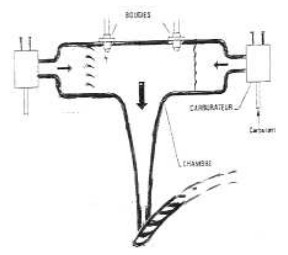
“REP gas turbine”
-The REP engines were robust and light and were initially characterized by the fan-shape arrangement of the cylinders.
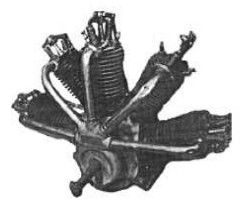
“REP five-cylinder, 25 CV”
They did not have a flywheel. The crankshaft had two crankpins: one for the front cylinders, which were three, and the other for the two rear ones.
-According to Robert, each crank was poorly used in the engines of the time, so he gathered several cylinders in one or two crankpins.
-He built the 5-cylinder 25 hp and 7-cylinder 35 hp fan-shape motors.
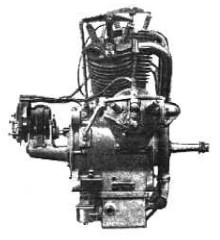
“Five-cylinder REP engine, side view”
-In this view we can see the Bosch magneto and the oil pan. The carburetor was inside, except the constant level reservoir that was outside.
-The control of the rocker arms was single lever, opening the two valves in a single movement.
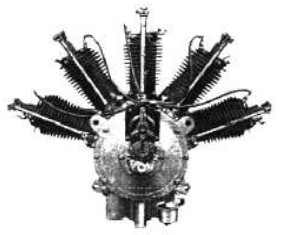
“Five-cylinder REP engine, rear view”
-The displacement of this model increased until it reached 50/60 CV with the engine in the below illustration.
-Thus, while in the first engines the cylinders measured 85 mm in bore, in the 60 hp engine they already had 110 mm by 160 mm of stroke.
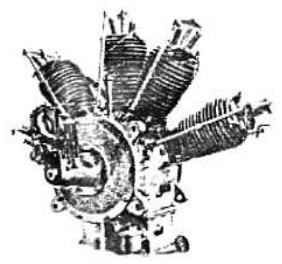
“Five-cylinder REP engine, 60 CV”
-These engines were built in England by Vickers and mounted on the Vickers Monoplanes 1 to 3.
-The double fan engine totaling 10 cylinders in which the rods all come out of the central part, so it is the union of two five-cylinder engines placed back to back.
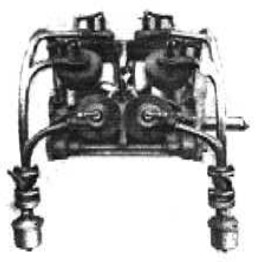
“REP 10-cylinder fan-shape engine”
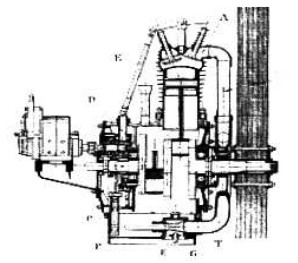
“REP engine single lever schematics”
-Below we show the cam-plate design with the three positions that it must execute.

“Cam plate on the right”
-The 7-cylinder fan engine also had its 14-cylinder version.
-We first see a photograph of the 7-cylinder engine. With four cylinders in one line and three interspersed, in the second.
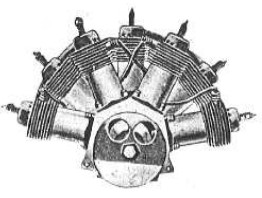
“REP 7-cylinder fan”
-The 7-cylinder required a two-pin crankshaft.
-In the diagram of the single-lever REP above, we can see the carburetor inside the oil pan, which prevents icing. (except the constant level bucket that was outside).
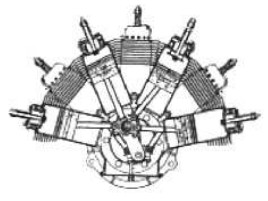
“Seven-cylinder REP engine, 35 CV”

“Seven-cylinder REP engine, cross-section”
-This engine had cylinders with a bore of 85 mm and a stroke of 90 mm, to give 35 CV of power in 1938.
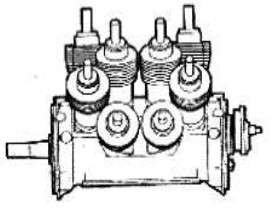
“REP 14-cylinder”
-In some models, REP applied the single intake and exhaust valve device.
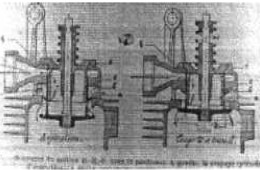
“REP's mono valve”
-Depending on the grade of opening, it opened exhaust or intake ports.
-The pistons were made of steel and the lubrication was castor oil.
-Evolution was constant: as the 7-cylinder engine of 1908 gave 35 CV, the 5-cylinder engine of 1910 (110mm x 110mm) exceeded 50 CV at 1,000 rpm and at 1,600 rpm it gave 60 CV.
-The 50 CV was the D model and weighed 150 Kg. The ignition of the fan-shape motors was by Bosch magnetos rotating at 5/4 of the engine speed.

“REP engine on REP aircraft”
-REP made radial engines of 5, 7, 10 and 14 cylinders. The one shown in the photograph above is a 7-cylinder mounted on an aircraft of the same brand.
-The 10 and 14 cylinders are double versions of the 5 and 7.
-We now add a first revision prepared for this chapter of REP, after having collected new information.
-Normally the Robert Esnault Pelterie fan-shape engines have not been photographed with the complex type of intake manifold and their carburetors.
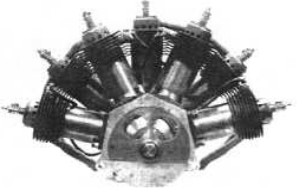
“Seven-cylinder REP engine”
-What we can see in the below illustration with collectors and carburetors, is that they are very separated from the engine.
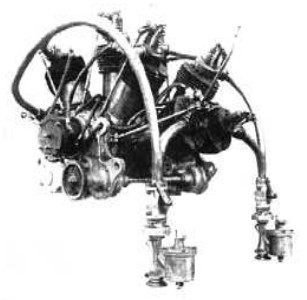
“Nice photo of the complete REP engine”
-If we look at the carburetors we have the expression of maximum simplicity. The venturi is bare on the outside, with its classic shape.
-An inclined duct leaves the constant level bowl, from its lower part, towards the neck of the venturi where the maximum depression is produced and allows the gasoline to flow into the intake air flow.
-Further up in the draft direction, there is the mixture stopcock, or gear control wing nut.
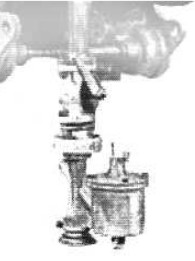
“7-Cylinder REP Carburetor”

“5 cylinder intake manifold”
-At the MAE there is an original REP engine on an exhibited hanging plane with an impeccable appearance as we can see below. And there is another one in the stock warehouse.

“Nice fan-shape REP engine, installed”

“REP, type D, 5-cylinder engine”
-In its 1907 Bulletin, the Société des Ingenieurs Civils de France, referred to the Robert Esnault Pelterie fan-shape engines that were very successful at the time.
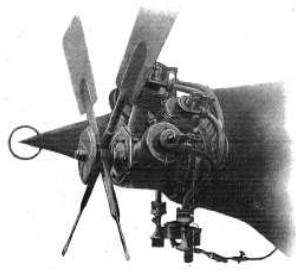
“REP engine on REP aircraft”
-This photograph can be confusing because it seems to use a strange propeller cone.
-This is the tip of the right wing that had a bicycle wheel to protect itself on the ground.
-At that time there were three models available, 5 and 7 cylinders.
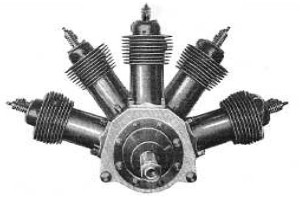
“REP 20-25 CV, five-cylinder”
-Below we show the 7-cylinder, type G, 30-35 hp.
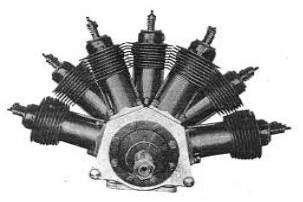
“REP type G, 7 cylinders”
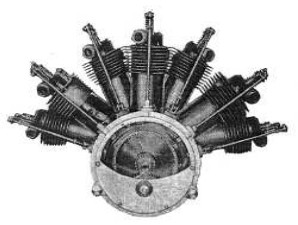
REP type E engine, also 7-cylinder
-We see that the type G has three cylinders at the rear and four at the front.
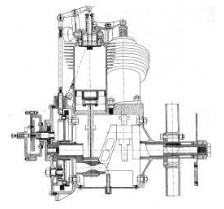
“REP type G, cross-section”
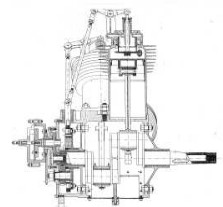
“REP, type E”
-In type E we see that the vertical cylinder corresponds to the front part.
-The connecting rod system, divided between two crankpins, have their master rod and their slave rods. As we see in the below photo.

“Interesting connecting rod system”
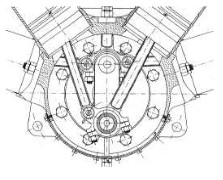
“The two front cylinders of the 5 cyl.”

“Connection of the four front cylinders of the 7-cyl.”
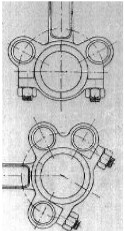
“Connection of the master rods”

“REP monovalve”
-As discussed in his biography, he was also considered the father of French astronautics for his studies and conferences on the subject of rockets for space navigation. He edited a book entitled "Considerations sur les Resultats d'un allegement infini des moteurs".
-Some publications have written the last name Pelterie as Peltrie. The one from Pelterie even appears in a street next to the Invalides station in Paris: “Rue Robert Esnault Pelterie”.
From Appendix 6: At the 1909 Paris Air Show, the 7-cylinder was shown installed on an airplane and with a four-blade propeller. It was the 7-cylinder that gave 35 hp at 1,400 rpm. It was an air-cooled, fan-shape with two rows of 4 and 3 cylinders respectively.
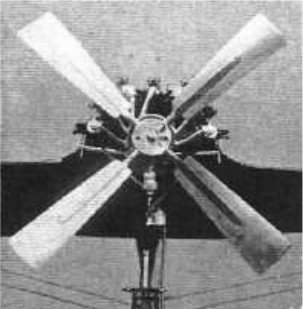
“REP 7-cylinder engine”
-The REP with 10 cylinders (two joined 5-cylinder engines) that gave 40 CV was also shown in 1909.

“The 10-cylinder REP”
-There are two magnetos (one for each group of 5 cylinders).
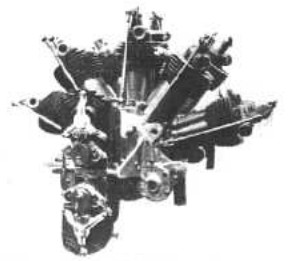
“Rear view of the previous engine”
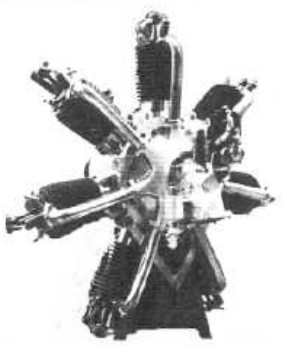
“REP radial, 95 CV”
We located a new view of the seven-cylinder fan engine, with a different arrangement of the carburetors compared to that shown in the main text.
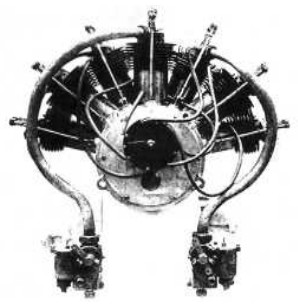
“REP 7-cylinder fan-shape engine, rear view”
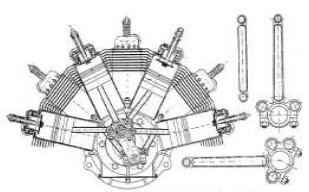
“Interior layout and detail of the connecting rods”
-This REP engine is from 1907, with seven cylinders giving 35 CV.
-As stated in the main text, Robert Esnault Pelterie was also a pioneer in rocket engine propulsion, (see).
-The Societé Astronomique de France established the REP-Hirsch Prize in his name.
From Appendix 7: The REP (see Robert Esnault Pelterie) 60 hp model is the seven-cylinder radial shown from the back. From the year 1911.
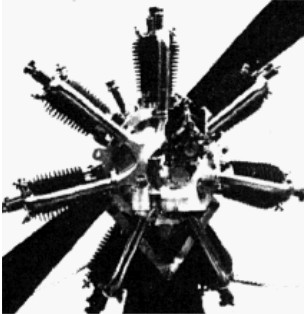
“REP radial engine, rear view”
From Appendix 9: We located a REP engine in Stockholm, at its Technical Museum.
-As you can see, it is well preserved and maintained.
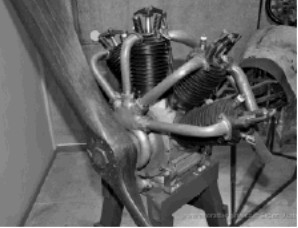
“REP 5-cylinder, fan-shape engine” (E-V, EAHS)

“REP 5-cylinder, fan-shape engine, front-top view”
-It is convenient to observe the shape of the intake manifold, or multiple as it is sometimes said: all the ducts come together in a kind of body as if there were a beater inside it.
-Beneath this piece there is an elbow that goes towards the carburetor at the lower rear of the engine. Right under the magneto.
-This is what the below photograph shows. And also some nice exhaust pipes with a sinuous shape somewhat harmonic to coincide on the sides, and somewhat lower than the plane's hull.
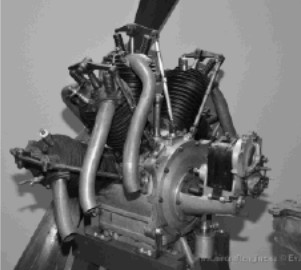
“Nice photo of the REP engine”
From Appendix 10: Two more illustrations of Robert Esnault Pelterie's seven-cylinder engine.
-The first one already appears in the main text and is type E, perhaps with better resolution now.
-The other engine may be the same, seen from the side of the rear (or front) cam plate
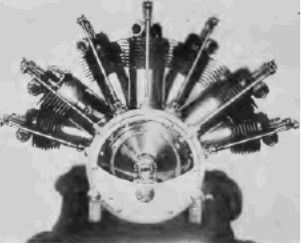
“REP, model E, visible cam plate”
-This is the mentioned photo of the possible same engine from another angle.
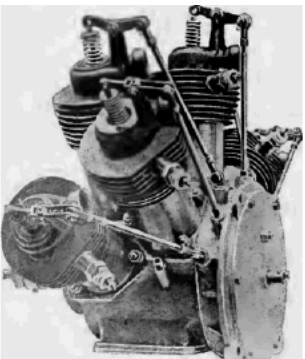
“Another view of the REP engine”
Engines of REP
Model: 10 cyl, fan, semi-radial
Arquitecture:
Cooling:
Total Displacement:
Bore / Stroke: x
Power:
Weight:
Model: 14 cyl, radial
Arquitecture:
Cooling:
Total Displacement:
Bore / Stroke: x
Power:
Weight:
Model: 5 cyl. fan, 25 CV Type D
Arquitecture:
Cooling:
Total Displacement:
Bore / Stroke: x
Power:
Weight:
Model: 5 cyl. fan, 60 CV
Arquitecture:
Cooling:
Total Displacement:
Bore / Stroke: x
Power:
Weight:
Model: 7 cyl. radial, 60 CV
Arquitecture:
Cooling:
Total Displacement:
Bore / Stroke: x
Power:
Weight:
Model: 7-cyl, fan, 35 CV
Arquitecture:
Cooling:
Total Displacement:
Bore / Stroke: x
Power:
Weight:


